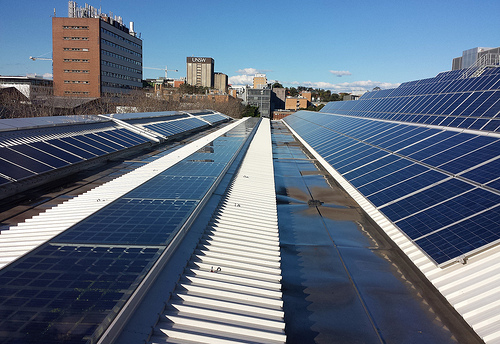
The Switch: Soon Solar Will Be the Cheapest Power Everywhere
Solar is already the cheapest available power across large swathes of the tropics, writes Chris Goodall - its cost down 99.7% since the early 70s. Soon it will be the cheapest electricity everywhere, providing clean, secure, affordable energy for all.
Towards the end of last year, Shell CEO Ben van Beurden made a little-noticed remark. He said that solar would become the "dominant backbone" of the world's energy system.
He didn't give a date for his prediction, or indeed define what 'dominant' means, but he accepted that the sun will eventually provide the cheapest energy source across almost all of the world.
July 22, 2016 | Source: The Ecologist | by Chris Goodall
Solar is already the cheapest available power across large swathes of the tropics, writes Chris Goodall – its cost down 99.7% since the early 70s. Soon it will be the cheapest electricity everywhere, providing clean, secure, affordable energy for all.
Towards the end of last year, Shell CEO Ben van Beurden made a little-noticed remark. He said that solar would become the “dominant backbone” of the world’s energy system.
He didn’t give a date for his prediction, or indeed define what ‘dominant’ means, but he accepted that the sun will eventually provide the cheapest energy source across almost all of the world.
This is what my new book, The Switch, is about. Just how long will it take to wean the world off fossil fuels using just the forces of the free market rather than quixotic governments? What technologies will we need to complement the intermittent power of the sun?
In some ways, van Beurden’s thought is an obvious one. The light and heat coming from the sun provides a continuous stream of about 90,000 terawatts of energy to the planet. (Don’t worry about the unit of measurement. The important thing is that this number is six thousand times the requirements of the entire world).
Energy needs will rise – probably doubling in the next 30 years – but even then we will only need to capture three hours’ worth of sunshine to provide everybody around the world with as much energy as they need every year.
For comparison, the power of the wind averages less than 1,000 terawatts, or two orders of magnitude less than solar energy. Wind is more difficult to collect and tends to blow far from centres of population. All other potential sources of renewable energy are smaller still, usually by factors of ten or one hundred.
Solar is already beating fossil fuels on price
Solar is also cheap, and getting cheaper every month. The price reduction has been steep and surprisingly consistent. Panels are being produced today for about one three hundredth – 0.3% – of the cost in the mid-1970s.
These cost reductions have been principally driven by the yearly increases in the volumes produced; since the commercialisation of photovoltaic panels began half a century ago the number of panels produced has grown by an average of about 40% a year. Solar installations continue to grow, now principally in China, India and other industrialising countries, and the volumes of panels installed continues to grow year after year, helping drive costs even lower.
In many parts of the world solar power is already the cheapest way of delivering electricity. In places as diverse as Chile, Abu Dhabi, parts of India or the islands of Hawai’i, recent auctions for new electricity generation capacity have demonstrated that photovoltaics can beat fossil fuels on price – no subsidy or special favours required.
As cost reductions continue, solar’s price advantage will spread almost everywhere around the globe. In remote mining settlements, villages in Kenya and rooftops in California PV is already being installed without a thought of alternatives. It is already, in van Beurden’s words, the backbone of energy supply in many locations.
Research scientists around the world are continuing to invent new ways of turning light into electricity using simpler and cheaper materials. In the book I talk to several technologists who are pioneering the next generation of solar panels. These will be incorporated in the glass of windows or hung on the outside of buildings.
Innovation in collecting energy from the sun at lower and lower cost has at least another half century of progress to come.
